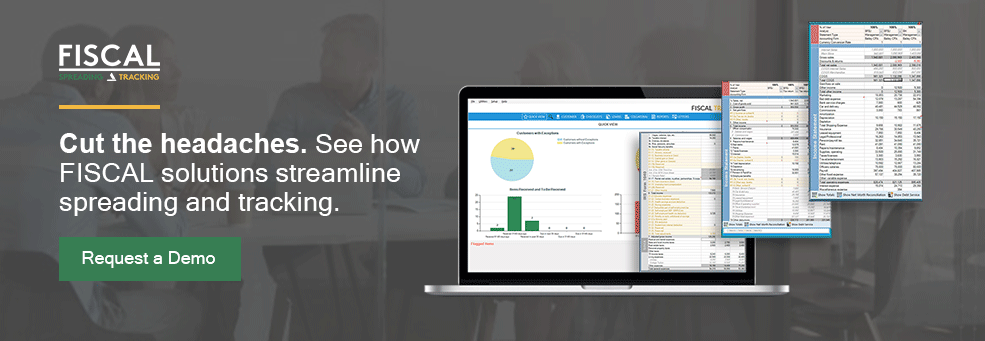Decades ago, the introduction of spreadsheet software mostly eliminated the physical act of “spreading” financial statements, running ratios on a calculator or creating a cash flow analysis by hand on a yellow legal pad. Most community banks and credit unions, regardless of size, turned to Excel for statement spreading and financial analysis, in the hope that it would streamline their processes and allow employees to spend more time analyzing why things happened, rather than calculating what happened in the first place.
Why Excel?
Excel is synonymous with spreadsheets, and simply put, many institutions use Excel because they already have it, they have some familiarity with it and it appears to be an ideal solution for spreading financial statements (or tax returns) and conducting some standard ratio and trends analysis.
Excel’s formulas and flexibility seem to be uniquely suited to the requirements of community banking and small business lending. Even institutions that started out small and have grown substantially often stick with an Excel-based system because it’s easier to just keep doing it the way you’ve always done it.

Does Excel really work for statement spreading?
Although small business lending necessitates a high degree of flexibility in the spreading process, Excel actually skews too far in this direction. At first working in Excel seems sufficient, but it actually gives rise to a number of significant issues, even for institutions with relatively simple deals and small portfolios.
Despite receiving mostly tax returns from their current or prospective borrowers, most institutions’ Excel template resembles a standard chart of accounts, meaning that the analyst or loan officer must “start from scratch” for each new deal, inserting new Rows, hiding or deleting unnecessary Rows, repurposing the existing accounts, or simply doing the mental conversion of putting values into Rows that do not exactly align with the tax return in front of them. All of these modifications are inefficient and time-consuming in and of themselves. The real downside comes after they’ve all been made, in making sure that the changes have been accounted for in your formulas.
The nature of financial analysis means that even a single mistake is unacceptable, but checking the formula on each and every Total row, Percent Change value or Ratio calculation to ensure that the changes were incorporated correctly can turn what should be a quick spread into an hours-long slog.
Layer on the fact that most community banks and credit unions review 2-3 years of financials and typically look to incorporate the Guarantors and even Related Entities into a Global Cash Flow, and you can easily spend an entire day or more analyzing a relatively small and simple loan request.
Save time and reduce mistakes in Excel with our ready-to-use Financial Statement Spreading Templates. Try them today!
End to End: Not The Only Option
Although they often recognize the problems inherent in Excel-based spreading, many small community banks and credit unions believe that their only other option is to take the plunge into one of the full end-to-end Loan Origination Systems (LOS) used by big regional and national banks. Not only are these systems incredibly complex to implement and cumbersome to use (not to mention expensive), but the approach to spreading is unacceptably rigid.
These big-bank systems often expect that you will always fill out the financials completely or that there will never be Unexplained Net Worth Variation. They’re designed for spreading Audited Financial Statements and blackboxing automated credit decisions, not for small business lending.
As a result, these smaller institutions continue to struggle with the shortcomings of Excel, fearing that making a change would mean losing the very flexibility that attracted them to Excel in the first place.

What is FISCAL SPREADING?
For community banks and credit unions that are looking to streamline their underwriting, improve standardization and consistency, and increase efficiency in the spreading process, all while maintaining the high degree of flexibility required in small business lending, FISCAL is built for you.
FISCAL SPREADING streamlines your underwriting process, without imposing structures that really work for large banks with large borrowers, not small business lending. Because we understand how community banks and credit unions work, we can keep you focused on your priorities by delivering standardization, consistency and flexibility.
If your institution has outgrown Excel, or you are just tired of checking every single formula in your spreads one by one, don’t think that you have to commit to a years-long implementation and spend hundreds of thousands of dollars to solve these problems. FISCAL Forward is your best bet. Rather than wasting time, money, and resources, contact us today to find out how FISCAL Forward is focused on you.




